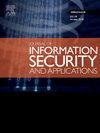High payload H.266/Versatile Video Coding (VVC) steganography based on affine motion estimation and chaotic maps
IF 3.7
2区 计算机科学
Q2 COMPUTER SCIENCE, INFORMATION SYSTEMS
Journal of Information Security and Applications
Pub Date : 2025-09-04
DOI:10.1016/j.jisa.2025.104212
引用次数: 0
Abstract
The widespread data breaches across the internet, along with the vast usage of high-definition and ultra-high-definition video applications, have prompted institutions to focus on developing steganography techniques for the next-generation video codec standard, H.266/Versatile Video Coding (VVC). This focus is attributed to VVC's superior technological capabilities, which offer a 50 % reduction in bitrate while allowing for a greater data embedding capacity. All while preserving comparable visual quality to its predecessor, H.265/High Efficiency Video Coding (HEVC). This paper proposes a video steganographic technique for the VVC standard that utilizes Motion Vectors (MVs) based on Affine Motion Estimation (AME) as confidential information carriers, where four novel chaotic maps are adopted to ensure a high level of system security. The paper’s contributions include a large payload approach based on MVs for the H.266 standard, along with the use of four novel chaotic maps to enhance system security. Simulation results proved that the proposed technique achieves an average hiding capacity of 73.760 Kbits per frame, significantly surpassing state-of-the-art methods accomplished in 1920 × 1080 video resolution with a difference Peak Signal to Noise Ratio (ΔPSNR) of -0.097 dB, a Bit Rate Increase (BRI) of 4.120 %, and at a Quantization Parameter (QP) of 32. Furthermore, the integration of four highly complex chaotic maps, featuring a large key space size of 2797, elevates the security of the suggested technique, rendering it nearly unbreakable against all types of brute-force cyberattacks.
基于仿射运动估计和混沌映射的高有效载荷H.266/多功能视频编码(VVC)隐写
互联网上广泛的数据泄露,以及高清和超高清视频应用的广泛使用,促使各机构专注于为下一代视频编解码标准H.266/通用视频编码(VVC)开发隐写技术。这主要归功于VVC卓越的技术能力,它提供50%的比特率降低,同时允许更大的数据嵌入容量。同时保留了与其前身H.265/高效视频编码(HEVC)相当的视觉质量。本文提出了一种基于仿射运动估计(AME)的运动矢量(mv)作为保密信息载体的VVC标准视频隐写技术,该技术采用了四种新颖的混沌映射,保证了系统的高安全性。本文的贡献包括基于H.266标准的mv的大有效载荷方法,以及使用四种新的混沌映射来增强系统安全性。仿真结果表明,该技术实现了平均每帧73.760 Kbits的隐藏容量,显著优于1920 × 1080视频分辨率下的现有方法,峰值信噪比(ΔPSNR)为-0.097 dB,比特率增加(BRI)为4.120%,量化参数(QP)为32。此外,四个高度复杂的混沌地图的集成,具有2797的大密钥空间大小,提高了所建议技术的安全性,使其几乎无法破解所有类型的暴力网络攻击。
本文章由计算机程序翻译,如有差异,请以英文原文为准。
求助全文
约1分钟内获得全文
求助全文
来源期刊

Journal of Information Security and Applications
Computer Science-Computer Networks and Communications
CiteScore
10.90
自引率
5.40%
发文量
206
审稿时长
56 days
期刊介绍:
Journal of Information Security and Applications (JISA) focuses on the original research and practice-driven applications with relevance to information security and applications. JISA provides a common linkage between a vibrant scientific and research community and industry professionals by offering a clear view on modern problems and challenges in information security, as well as identifying promising scientific and "best-practice" solutions. JISA issues offer a balance between original research work and innovative industrial approaches by internationally renowned information security experts and researchers.
 求助内容:
求助内容: 应助结果提醒方式:
应助结果提醒方式:


